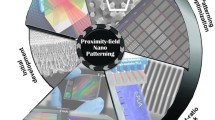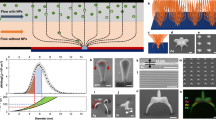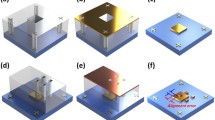Abstract
Recently, three-dimensional (3D) nano-processing technology that can increase design freedom and space efficiency of devices has been being rapidly developed, and is highly expected to provide a key path for the development of next-generation optical devices. This technology has shown a high possibility of success in realizing the future devices, but still are facing many challenges in the popularization and practical application. In particular, the ability of quickly, precisely, and stably fabricating complex 3D nanostructures composed of many individual elements is strongly demanded. In recent years, the so-called four-dimensional (4D) nanofabrication technology is attracting attention. The 4D nanofabrication is achieved by applying an external force to manufactured two-dimensional nanostructures, inducing deformation in time, and then precisely transforming them into 3D nanostructures. The 4D nanofabrication technology with excellent flexibility, versatility, functionality, and reconfiguration properties provides a new paradigm enabling effectively control the mechanical, electrical, and optical properties of existing materials. In this review, we examine the conventional methods for fabricating 3D nanostructures, and then investigate 4D nanofabrication technology in detail.




Similar content being viewed by others
References
Komanduri, R., Chen, J., P. Malshe, A., Doumanidis, H., Rajurkar, K. P., "NSF-EC workshop on nanomanufacturing and processing: a summary report," Proc. SPIE 4936, Nano- and Microtechnology: Materials, Processes, Packaging, and Systems (2002)
C.M. Soukoulis, M. Wegener, Past achievements and future challenges in the development of three-dimensional photonic metamaterials. Nat. Photonics 5, 523–530 (2011)
J. Langer et al., Present and future of surface-enhanced Raman scattering. ACS Nano 14, 28–117 (2020)
S. Yi et al., Subwavelength angle-sensing photodetectors inspired by directional hearing in small animals. Nat. Nanotechnol. 13, 1143–1147 (2018)
J. Shin, Overcoming the diffraction limit with metamaterials. Phys. High Technol. 21, 2 (2012)
M. Kadic, G.W. Milton, M. van Hecke, M. Wegener, 3D metamaterials. Nat. Rev. Phys. 1, 198–210 (2019)
S.J.B. Yoo, 2D and 3D heterogeneous photonic integrated circuits. 2016 Opt. Fiber Commun. Conf. Exhib. OFC (2016). https://doi.org/10.1117/12.2047502
A. Shakouri, B. Liu, P. Abraham, J.E. Bowers, 3D photonic integrated circuits for WDM applications. Wavel. Div. Mult. A Crit. Rev. 10293, 102930I (1999)
M.-L. Hsieh, P. Kuang, J.A. Bur, S. John, S.-Y. Lin, Review on recent progress of three-dimensional optical photonic crystal. AIP. Conf. Proc. 1590, 204–209 (2014)
H. Chu et al., 4D printing: a review on recent progresses. Micromachines 11, 796 (2020)
T. Jeon, D.H. Kim, S.G. Park, Holographic fabrication of 3D nanostructures. Adv. Mater. Interfaces 5, 1–13 (2018)
S. Jeon et al., Fabricating complex three-dimensional nanostructures with high-resolution conformable phase masks. Proc. Natl. Acad. Sci. USA 101, 12428–12433 (2004)
Q. Geng, D. Wang, P. Chen, S.C. Chen, Ultrafast multi-focus 3-D nano-fabrication based on two-photon polymerization. Nat. Commun. 10, 1–7 (2019)
J.D. Fowlkes et al., Simulation-guided 3D nanomanufacturing via focused electron beam induced deposition. ACS Nano 10, 6163–6172 (2016)
A. Fernández-Pacheco et al., Three dimensional magnetic nanowires grown by focused electron-beam induced deposition. Sci. Rep. 3, 1 (2013)
P.F.A. Alkemade, E.M. Koster, E. Van Veldhoven, D.J. Maas, Imaging and nanofabrication with the helium ion microscope of the van Leeuwenhoek laboratory in Delft. Scanning 34, 90–100 (2012)
H. Zhao et al., Nanofabrication approaches for functional three-dimensional architectures. Nano Today 30, 100825 (2020)
H. Qiu, Z.M. Hudson, M.A. Winnik, I. Manners, Multidimensional hierarchical self-assembly of amphiphilic cylindrical block comicelles. Science 347, 1329–1332 (2015)
X. Liu et al., Complex silica composite nanomaterials templated with DNA origami. Nature (2018). https://doi.org/10.1038/s41586-018-0332-7
L.L. Ong et al., Programmable self-assembly of three-dimensional nanostructures from 10,000 unique components. Nat. Publ. Gr. (2017). https://doi.org/10.1038/nature24648
J.H. Cho et al., Nanoscale origami for 3D optics. Small 7, 1943–1948 (2011)
J.S. Randhawa, M.D. Keung, P. Tyagi, D.H. Gracias, Reversible actuation of microstructures by surface-chemical modification of thin-film bilayers. Adv. Mater. 22, 407–410 (2010)
Z. Tian et al., Deterministic self-rolling of ultrathin nanocrystalline diamond nanomembranes for 3D tubular/helical architecture. Adv. Mater. 29, 1604572 (2017)
P.O. Vaccaro, K. Kubota, T. Fleischmann, S. Saravanan, T. Aida, Valley-fold and mountain-fold in the micro-origami technique. Microelectronics J. 34, 447–449 (2003)
Z. Liang Wu et al., Three-dimensional shape transformations of hydrogel sheets induced by small-scale modulation of internal stresses. Nat. Commun. (2013). https://doi.org/10.1038/ncomms2549
J. Zanardiocampo, Characterization of GaAs-based micro-origami mirrors by optical actuation. Microelectron. Eng. 73–74, 429–434 (2004)
E. Smela, O. Inganäs, I. Lundström, Controlled folding of micrometer-size structures. Science (80–) 268, 1735–1738 (1995)
J.H. Na et al., Programming reversibly self-folding origami with micropatterned photo-crosslinkable polymer trilayers. Adv. Mater. 27, 79–85 (2015)
J.S. Randhawa et al., Pick-and-place using chemically actuated microgrippers. J. Am. Chem. Soc. 130, 17238–17239 (2008)
A.J. Nichol, P.S. Stellman, W.J. Arora, G. Barbastathis, Two-step magnetic self-alignment of folded membranes for 3D nanomanufacturing. Microelectron. Eng. 84, 1168–1171 (2007)
J.C. Breger et al., Self-folding thermo-magnetically responsive soft microgrippers. ACS Appl. Mater. Interfaces 7, 3398–3405 (2015)
M.K. Blees et al., Graphene kirigami. Nature 524, 204–207 (2015)
D.Y. Khang, H. Jiang, Y. Huang, J.A. Rogers, A stretchable form of single-crystal silicon for high-performance electronics on rubber substrates. Science (80–) 311, 208–212 (2006)
Z. Yan et al., Three-dimensional mesostructures as high-temperature growth templates, electronic cellular scaffolds, and self-propelled microrobots. Proc. Natl. Acad. Sci. 114, E9455–E9464 (2017)
Y. Zhang et al., Printing, folding and assembly methods for forming 3D mesostructures in advanced materials. Nat. Rev. Mater. 2, 1–17 (2017)
W. Liu, Q. Zou, C. Zheng, C. Jin, Metal-assisted transfer strategy for construction of 2D and 3D nanostructures on an elastic substrate. ACS Nano 13, 440–448 (2019)
J. Li, Z. Liu, Focused-ion-beam-based nano-kirigami: from art to photonics. Nanophotonics 7, 1637–1650 (2018)
H. Zhao, Y. Lei, 3D nanostructures for the next generation of high-performance nanodevices for electrochemical energy conversion and storage. Adv. Energy Mater. 10, 2001460 (2020)
Q. Xu et al., Three-dimensional micro/nanoscale architectures: fabrication and applications. Nanoscale 7, 10883–10895 (2015)
S. Chen, J. Chen, X. Zhang, Z.-Y. Li, J. Li, Kirigami/origami: unfolding the new regime of advanced 3D microfabrication/nanofabrication with “folding.” Light Sci. Appl. 9, 1–19 (2020)
S.W. Robbins et al., Block copolymer self-assembly-directed synthesis of mesoporous gyroidal superconductors. Sci. Adv. 2, e1501119 (2016)
P.W. Majewski et al., Resilient three-dimensional ordered architectures assembled from nanoparticles by DNA. Sci. Adv. 7, 1–11 (2021)
C. Dai, J.H. Cho, In situ monitored self-assembly of three-dimensional polyhedral nanostructures. Nano Lett. 16, 3655–3660 (2016)
W. Lee et al., Two-dimensional materials in functional three-dimensional architectures with applications in photodetection and imaging. Nat. Commun. 9, 1–9 (2018)
Z. Liu et al., Nano-kirigami with giant optical chirality. Sci. Adv. 4, 1–9 (2018)
Y. Mao et al., Programmable bidirectional folding of metallic thin films for 3D chiral optical antennas. Adv. Mater. 29, 1606482 (2017)
W. Xu et al., Ultrathin thermoresponsive self-folding 3D graphene. Sci. Adv. 3, e1701084 (2017)
M. Humood et al., Fabrication and deformation of 3D multilayered kirigami microstructures. Small 14, 1–9 (2018)
Acknowledgements
This work was financially supported by the National Research Foundation of Korea (Grant Nos. 2019M3E4A1078663, 2020R1A2C2010967), the KIST Institutional Program (Grant No. 2E31021-21-029), Institute for Information and Communications Technology Planning and Evaluation (IITP) Grant (Grant No. 2020-0-00947), and the KU-KIST School Project.
Author information
Authors and Affiliations
Corresponding author
Additional information
Publisher's Note
Springer Nature remains neutral with regard to jurisdictional claims in published maps and institutional affiliations.
Rights and permissions
About this article
Cite this article
Kim, M., Kim, MK. Four-dimensional nanofabrication for next-generation optical devices. J. Korean Phys. Soc. 81, 516–524 (2022). https://doi.org/10.1007/s40042-022-00409-x
Received:
Accepted:
Published:
Issue Date:
DOI: https://doi.org/10.1007/s40042-022-00409-x




